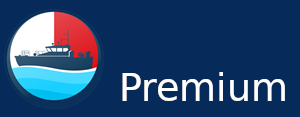By Steven Detre (Saab Technologies)
Port operations, whether these are being performed on water or on land, are often not without risk. Pilots boarding a ship while sailing, navigating through narrow passages, collision avoidance with other smaller or larger vessels, discharging and moving cargo on land, walking between container handling equipment and trucks…
Although overall personal safety has been significantly improved over the last 2 decades due to increased awareness and the implementation of all sorts of technology, unfortunately accidents are still happening every day. In 2019 alone over 900 persons got injured and 60 people lost their lives at sea. Due to the nature of the business, where workers are constantly surrounded by very large machines and cargo, accidents often have a very high impact on human lives. So already considering the human aspect, prevention should be on top of every operational manager or Captain.
Though besides the human tragedy, there is also an economic impact when an accident has happened. Repair or loss of equipment costs a lot of money. Suppose a ship sinks or a ship-to-shore crane is hit by a docking ship. Also the loss of cargo at sea or on land have their price. But it doesn’t stop there. Equipment under repair also means that this equipment cannot be used operationally, meaning less revenue. It can also be that a ship which have had an accident is blocking the entrance to a port meaning a huge economic loss for not only the port but also all the economic region which is depending on this port. In such case, the port will react quickly in order to salvage the vessel. However quick action is not always possible. Weather conditions, the state of the vessel (can it be towed or will it break up into different parts when trying to salvage) and size of the vessel determine how fast the situation can be resolved.
Accidents at or near the quay may result in the fact that a quay, or part of it, can temporarily not be used for operations. This means that the foreseen work has to be executed by the remaining equipment, which puts increased pressure on the planning and on the remaining equipment. The foreseen cargo at its turn needs to be located somewhere else on the terminal, or in worst case will have to go to a competitive terminal.
Second to last, when talking about accidents we also have to look at the impact on the environment. Besides the cargo, which can contain substances which can severely impact marine life also on the long term, ships typically contain large amounts of fuel which come into the environment if a ship would get lost at sea.
Finally, in case of accidents, an investigation will be started to determine the cause of the accident. In such case it is crucial for a port to be able to have all necessary required data regarding the actions and timeline of events (communication, navigation, actions…). As costs involved (damage repair, salvage and other benefits, reputational damage…) may be significant (ref. event in the Suez Canal) being able to determine the root case and responsible is an extremely important part of the settlement of the accident. And in case it concerns criminal acts, there needs to be proof in order to be able to start prosecution. But also for maritime safety in general, being able to playback the actions before the incident could give insightful information to how avoiding such accidents in the future.
In case of severe accidents, there often also is large media coverage which can lead to reputational damage. Such damage needs to be taken into consideration as well when looking at the cost of damage prevention. E.g. terminals which have a bad reputation in terms of H&S, often find it difficult to attract well qualified personnel. Studies have shown that organizations that fail to care for their personnel also suffer from lack of motivation resulting in lower productivity of the people already working for the organization.
So the costs of an accident in a port are always very high. Whether we look at the human cost, economic cost or environmental cost. Costs which are often very difficult to calculate upfront.
Now before discussing how to prevent accidents, we need to look at the causes of accidents. Most common causes are:
- Failure to comply with safety regulations and standards,
- Inadequate number of staff,
- Inexperienced or improper trained staff,
- Fatigue,
- Intoxication,
- Dangerous weather conditions,
- Improperly loaded or fixed cargo,
- Equipment malfunctioning,
- Or a combination of the above.
As you can see, most of the causes for accidents are human based. Accidents caused by dangerous weather conditions and improperly loaded cargo are both related to poor judgement. Equipment malfunctioning are often due to improper maintenance.
Now we know the root causes, we can act to minimize the risk. Management systems such as VTS, Port Management Information Systems and Terminal Operating systems play a key role in minimizing and managing risks. Through thorough planning, situations which have a high chance of leading to an accident (e.g. congested port or terminal), can be minimized or avoided. VTS and other navigational systems help captains and pilots navigating ships safely in crowded port environments.
Port Management Information Systems help with the planning of the vessel calls, checking of shipping manifests on dangerous goods, staff accreditations and experience. And once an incident has occurred, PMIS can help with the planning and coordination of the SAR, mitigation or salvage activities.
Finally Terminal Operating Systems help Terminal operators to plan the activities on the yard as well as the resources required to move the cargo to and from the ship in the safest way. Experiences, certificates and training background info is available and can automatically be checked against the requirements for the planned job.
The logistical chain between the Fairway and the Freeway is expected to run smooth and efficient. In reality this often require activities which bear a certain risk for accidents and which therefore need to be executed carefully. Proper planning and correct and sufficient data can help responsible operators in mitigating the risks.


